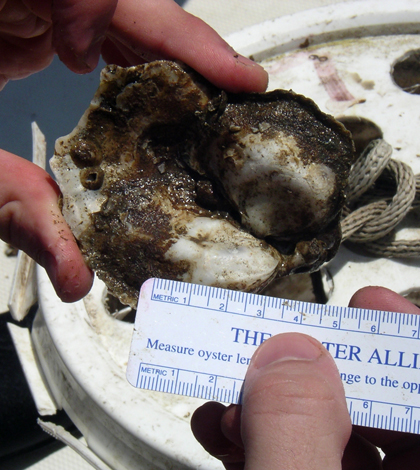Restored oyster reefs in Potomac River could make deep cuts in excess nutrients

Measuring an oyster from a restoration project in Eastern Bay (Credit: NOAA)
Researchers are looking outside the box and inside the shells of entire oyster populations for new methods to combat eutrophication.
A new study led by the U.S. Geological Survey and the National Oceanic and Atmospheric Administration says that cultivating and restoring oyster reefs in the Potomac River estuary could improve its water quality.
The Chesapeake Bay and its estuaries — including the Potomac — are well studied, said Suzanne Bricker, manager of NOAA’s National Estuarine Eutrophication Assessment. The Bay is home to one of the world’s largest hypoxic zones, a result of excessive nutrient loads and subsequent eutrophication. Two NOAA studies from the past two decades examined the causes, conditions and future outlook of eutrophication in the Bay.
“The goal of the assessments was to evaluate the magnitude, location and severity of the problem, and to provide the basis for development of management measures to help solve the problem,” Bricker said. Eutrophication, Bricker noted, “is a pervasive problem both nationally and internationally.”
With the knowledge gleaned from the studies in the early 1990s and 2000s, NOAA began exploring alternative methods to take on the eutrophication threat. That included the cultivation of oysters, which feed through filtration. Even small communities of the shellfish are able to efficiently rid water of algae.
The researchers knew that shellfish cultivation had already proven itself as a means of managing nutrient loads in countries such as Sweden and China — the former nation having consciously performed shellfish aquaculture, while the latter enjoyed the water quality benefits as a secondary byproduct of increased seafood production.
“Although there are no leases in Potomac River at present, we wanted to look at the ‘what if’ scenario in the event that leases of oyster aquaculture were approved at some time in the future,” Bricker said.
The researchers chose the Potomac River as a case study since it was one of the 141 estuaries included in the two previous studies and is representative of conditions in Chesapeake Bay and regional estuaries, she said. They also wanted to update the assessment because loads have declined since the early 2000s. The river’s slow flow makes it particularly suitable for algae growth and therefore vulnerable to eutrophication, Bricker said.
The new study, published in the May 2014 issue of Aquatic Geochemistry, evaluated nitrogen loads in the Potomac River and modeled data using the Farm Aquaculture Resource Management model to determine how much nitrogen the oysters could remove from the system.
Field personnel gathered samples from headwater streams in Maryland and Virginia and sent the samples to laboratories for chemical analysis. Stage recorders automatically monitored stream levels. The Maryland Department of Natural Resource provided additional data.
The research found that oyster aquaculture could indeed improve water quality in the region. The study suggests that cultivation of only 15 to 20 percent of the estuary’s bottom could cut inbound nutrients by half. The other half would be handled through more traditional methods.
“We are suggesting oyster aquaculture as a complement, not instead of the land-based measures,” Bricker said. “Point and non-point measures should still be implemented and improved.”
Whether or not oyster aquaculture is implemented in the Potomac River remains to be seen, but aquaculture leases already underway in tributaries such as the St. Mary’s River could provide a model for future projects.
The study is just one part of NOAA’s efforts to increase shellfish populations in the country’s coastal waters, Bricker said. The 2011 National Shellfish Policy officially recognized the potential benefits of oyster aquaculture in improving water quality and domestic seafood production.
The agency is also studying eutrophication in Long Island Sound and the Great Bay-Piscataqua Estuaries with the assistance of the U.S. Environmental Protection Agency, the Long Island Sound Study and the University of New Hampshire.





0 comments